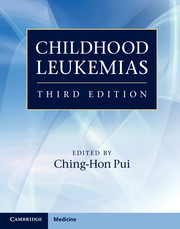Book contents
- Frontmatter
- Contents
- List of contributors
- Preface
- Section 1 History and general issues
- Section 2 Cell biology and pathobiology
- 4 Immunophenotyping
- 5 Immunoglobulin and T-cell receptor gene rearrangements
- 6 Cytogenetics of acute leukemias
- 7 Molecular genetics of acute lymphoblastic leukemia
- 8 Molecular genetics of acute myeloid leukemia
- 9 Epigenetics of leukemia
- 10 Genetics and cellular drug resistance in acute leukemia
- 11 Heritable predisposition to childhood hematologic malignancies
- Section 3 Evaluation and treatment
- Section 4 Complications and supportive care
- Index
- Plate Section
- References
9 - Epigenetics of leukemia
from Section 2 - Cell biology and pathobiology
Published online by Cambridge University Press: 05 April 2013
- Frontmatter
- Contents
- List of contributors
- Preface
- Section 1 History and general issues
- Section 2 Cell biology and pathobiology
- 4 Immunophenotyping
- 5 Immunoglobulin and T-cell receptor gene rearrangements
- 6 Cytogenetics of acute leukemias
- 7 Molecular genetics of acute lymphoblastic leukemia
- 8 Molecular genetics of acute myeloid leukemia
- 9 Epigenetics of leukemia
- 10 Genetics and cellular drug resistance in acute leukemia
- 11 Heritable predisposition to childhood hematologic malignancies
- Section 3 Evaluation and treatment
- Section 4 Complications and supportive care
- Index
- Plate Section
- References
Summary
Introduction
The term epigenetics refers to biochemical modifications of chromatin that without changing the primary structure of DNA, its sequence, have an effect on chromatin function. Initially study of epigenetic changes focused on their effects on gene expression regulation, although more recently it has become apparent that epigenetics modifications have multiple roles in chromatin control including DNA repair. At present and from a clinical perspective, the term epigenetic includes three global processes: DNA methylation, histone code alterations, and more recently microRNA expression and regulation. This last process is closely inter-related with the control of DNA methylation and potentially histone code modifications. Also and more recently, a number of genetic lesions in genes such as TET2, ASXL1, IDH1 and IDH2, EZH2, and DNMT3A have been described in human leukemias. These genetic lesions have important effects on epigenetics and link both fields. From a therapeutic perspective, clinicians currently have access to a number of anti-cancer agents with either DNA-hypomethylating activity or with the capacity to induce histone deacetylase (HDAC) inhibition.
Since the late 1990s, there have been intense efforts to identify epigenetic changes in cancer, and in leukemia in particular. This work was stimulated by the realization that epigenetic alterations are very common in leukemia and that epigenetic information could have a significant translational impact by helping in the development of new prognostic biomarkers and therapeutic targets. This chapter reviews the translational information currently known pertaining epigenetics, mainly aberrant DNA methylation, and human leukemia. It includes a summary of known epigenetic defects in specific leukemias and prognostic use and clinical experience with anti-leukemia agents with known epigenetic effects.
- Type
- Chapter
- Information
- Childhood Leukemias , pp. 239 - 256Publisher: Cambridge University PressPrint publication year: 2012

